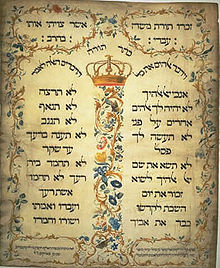Ten Commandments
From Wikipedia, the free encyclopedia
(Redirected from Sixth Commandment)
For other uses, see Ten Commandments (disambiguation).
| Part of a series on |
| The Ten Commandments |
Ten Commandments
|
| The commandments |
I am the LORD thy God
Thou shalt have no other gods No graven images or likenesses Not take the LORD's name in vain Remember the sabbath day Honour thy father and thy mother Thou shalt not kill Thou shalt not commit adultery Thou shalt not steal Thou shalt not bear false witness Thou shalt not covet |
| Related articles |
The Ten Commandments, also known as the Decalogue, are a set of biblical principles relating to ethics and worship, which play a fundamental role in Judaism and most forms of Christianity. They include instructions to worship only God and to keep the Sabbath, and prohibitions against idolatry, blasphemy, murder, theft, andadultery. Different groups follow slightly different traditions for interpreting and numbering them.
The Ten Commandments appear twice in the Hebrew Bible, in the books of Exodus and Deuteronomy. According to the story in Exodus, God inscribed them on two stone tablets, which he gave to Moses on Mount Sinai. Modern scholarship has found likely influences in Hittite and Mesopotamian laws and treaties, but is divided over exactly when the Ten Commandments were written and who wrote them.
| Commandments |
'Thou shalt not make unto thee any graven image, or any likeness of any thing that is in heaven above, or that is in the earth beneath, or that is in the water under the earth. Thou shalt not bow down thyself to them, nor serve them: for I the LORD thy God am a jealous God, visiting the iniquity of the fathers upon the children unto the third and fourth generation of them that hate me;'
— Exodus 20:4-6 (KJV)
|
|---|
The mount was covered by the cloud for six days, after which Moses went into the midst of the cloud and was "in the mount forty days and forty nights." (Exodus 24:16-18) And Moses said, "the LORD delivered unto me two tables of stone written with the finger of God; and on them was written according to all the words, which the LORD spake with you in the mount out of the midst of the fire in the day of the assembly." (Deuteronomy 9:10) Before the full forty days expired, the children of Israel decided that something happened to Moses, and compelled Aaron to fashion a golden calf, and he "built an altar before it" (Ex.32:1–5) and the people "worshipped" the calf. (Ex.32:6–8) After the full forty days, Moses and Joshua came down from the mountain with the tables of stone: "And it came to pass, as soon as he came nigh unto the camp, that he saw the calf, and the dancing: and Moses’ anger waxed hot, and he cast the tables out of his hands, and brake them beneath the mount." (Ex.32:19) After the events in chapters 32 and 33, the LORD told Moses, "Hew thee two tables of stone like unto the first: and I will write upon these tables the words that were in the first tables, which thou brakest." (Ex.34:1) "And he wrote on the tables, according to the first writing, the ten commandments, which the LORD spake unto you in the mount out of the midst of the fire in the day of the assembly: and the LORD gave them unto me." (Deuteronomy 10:4)
----------
According to Jewish tradition, Exodus 20:1–17 constitutes God's first recitation and inscription of the ten commandments on the two tables,[11] which were broken in pieces by Moses, and later rewritten on replacement stones and placed in the ark of the covenant;[12] and Deuteronomy 5:4–20 consists of God's re-telling of the ten commandments to the younger generation who were to enter the promised land. The passages in Exodus 20 and Deuteronomy 5 contain more than ten imperative statements, totalling 14 or 15 in all. While the Bible itself assigns the count of "ten", using the Hebrew phraseasereth ha-debarim ('the ten words', 'statements' or 'sayings'), the phrase does not appear in Exodus 20 or Deuteronomy 5.[13]

No comments:
Post a Comment